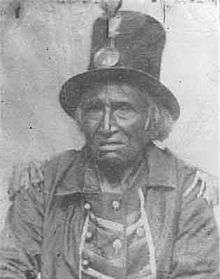Tamaha (Dakota leader)

Standing Moose or more commonly as Tamaha (c. 1776-1864) was a Mdewakanton Dakota. "Ta" is 'moose' in the Dakota language. Born near Winona, Minnesota, he lost an eye in an accident as a child so he was called "One eye", which the French called him "Le Borgne", or "One Eye." English picked up the name as "the One-eyed Sioux."
In 1806 and 1807, Tamaha became a friend of U.S. Army lieutenant Zebulon M. Pike. Pike identified his Indian guide as Tahamie, as L’Orignal Leve’, and Rising Moose[1][2], and his name was also written Tahama and Tammahaw[3], as well as Tamahay[4]. He was one of the Sioux leaders who supported the United States in the War of 1812. He retained his loyalty even after his capture by the British, during which he refused to divulge information about the Americans on pain of death (a threat which turned out to be a bluff). Because of his loyalty to America, Tamaha was presented a Peace Medal and Loyalty papers by William Clarke. These papers can be seen at the Minnesota History Center. Tamaha carried these papers with him and would charge people to see them.
Tamaha was known as a powerful orator and a diplomat of unusual ability. Wearing his trademark stovepipe hat, he managed to maintain amicable relations between whites and Indians. Before the Dakota War of 1862, Tamaha stood before Little Crow and advised him not go to war against the whites.[5] Tamaha died in 1864 after the Dakota War. According to Charles Eastman he died at Fort Pierre S.D.[6]
Notes
- ↑ Coues, Elliott (1895). The Expeditions of Zebulon Montgomery Pike, to Headwaters of the Mississippi River, through Louisiana Territory, and in New Spain, During the Years 1805-6-7. Vol I. Memoir of the Author- Mississippi Voyage. New York: Francis P. Harper. p. 87.
- ↑ Neill, Edward Duffield (1858). The History of Minnesota: from the Earliest French Explorations to the Present Time. Philadelphia: J. B. Lippincott & Co. p. 288.
- ↑ Hodge, Frederick Webb (2003). Handbook of American Indians North of Mexico. Scituate, MA: Digital Scanning, Inc. p. 680. ISBN 1-58218-751-7.
- ↑ Eastman, Charles (1997). Indian Heroes and Great Chieftains. Dover: Dover Publications, Inc., republication, originally published by Little, Brown and Company, Boston, 1918. p. 27. ISBN 0-486-29608-3.
- ↑ This speech can be found in Indian Heroes and Great Chieftains by Charles Eastman
- ↑ http://www.history.navy.mil/danfs/t1/tamaha.htm